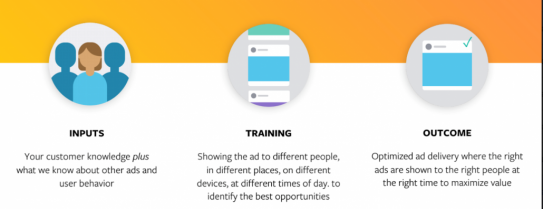
Why you should take advantage of Facebook's machine learning
Imagine you’re planning to buy something, and you start your online quest on Google, Pinterest, or a marketplace. You then turn to Facebook or Instagram to see what keeps the world busy and then hu?!?
You see a series of inspiring ads for what you’ve just been searching for. Is Facebook spying on you? Did someone hack your browser’s history? Is Siri eavesdropping on you? How do they know you are planning to buy that exact same product? The secret is Facebook’s machine learning and you better take advantage of it. We tell you why!
It gives you access to a massive amount of shopping behavior
It’s true, Facebook holds a massive amount of data. It’s the power of Facebook, Instagram, and WhatsApp combined, and that’s why they should always be in your marketing mix. As we move around the platform, we all leave pieces of information behind. Think about brand preferences, your taste in e.g. fashion, drinks or technology, shopping behavior and so on... Next to its own data collection, Facebook also leases information from other third party sources like Epsilon, Acxiom, Datalogix, and BlueKai. This data is paired up with your demographic data to predict your interest in products and services. Thanks to constant testing, Facebook optimizes the ad delivery for people who are most likely to convert within the chosen objective:

Since 2019, major improvements have been made to the algorithm, that create opportunities for marketers to not stick to the classic marketing funnel anymore and to push people faster down the purchasing process.
It disrupts the usual sales funnel thanks to machine learning
Before launching any campaign, you always start with a strategy. Who is our core target audience? What main message do we want to bring across? And how are we going to make people convert? You then start visualizing the classic sales funnel that goes from Brand Awareness to Consideration and ends in Conversion (or retention). When someone has already interacted with your content, the likelihood of conversion goes up. That’s why we normally scale down the funnel to the acquired remarketing audiences since they tend to have a lower cost per acquisition. But it’s time to disrupts this classic funnel approach and leverage the advantages of machine learning from Facebook. This is how we do it: In the brand awareness phase, we create interest-based audiences (including high-value look-a-likes) and select video content as the best performing format, in which we tell the product or brand story within max. 20 seconds. Normally we would only show the static consideration and conversion ads to people who have already seen the video, who interacted with high-value pages or who interacted with our Facebook/Instagram page. We still integrate those remarketing audiences into our campaign, but we now show all ads from all phases and we leave out the ones that have already converted. Why? The system needs to collect enough data, so it can optimize for your chosen objective and the likelihood of conversion. We let all ads run simultaneously and by closely monitoring and optimizing towards the lowest CPA (Cost Per Acquisition), we get faster conversion results than before. Muchas gracias machine learning! :) Can we prove it? Yes, we can! Take for example an e-commerce customer selling a relatively unknown vitamin supplement. We launched a campaign that would boost the sales for 4 products on their site. The campaign took off and KPI’s like CPM (Cost Per 1000 Impressions), CPC (Cost per Click), CTR (Click Through Rate) all looked very good. But when it came to conversions, they were lagging behind a little. We then decided to show every possible A/B test and format to all audiences, no matter which phase they were in. This resulted in an increase in conversions of 300% in the second week of testing.
Essential elements to maximize your machine learning
If you want to maximize your results, you have to add these elements to your campaign:
- Always add the Facebook pixel on your website and turn on advanced matching (to better match your website visitors to people on Facebook)
Only this way data collection on-site is ensured, plus conversion attribution is more accurate
- Link your offline conversion data sources (if you also sell in physical shops, so people buying offline can be matched with their online profiles)
- Use as many ad placements as possible (a minimum of 4).
The more placements like the newsfeed, stories, messenger, and the audience network (=reaching people on partner websites/apps of Facebook. Example: Tinder and TikTok), the better the system can optimize and look for platforms with the lowest CPA. In our case, we always customize the ads for each placement
- A/B test between visuals, ad formats, and copyrights. We advise using at least 3 different formats (video, carousel, linkpost, collection ad...) depending on the objective you have selected.
- Try to avoid frequent updates to your setup, since it will reactivate the learning process
- Free up sufficient media budgets: low budgets don’t allow the system to reach enough people and enable the algorithm to optimize your campaign (take into account that you need around 50 conversion events on-site to get out of the learning phase)
The future of machine learning
As technology gets more refined, systems like Google and Facebook will always learn more and optimize more. We (and you) as online marketing specialists benefit enormously from all this data and it allows us to keep on personalizing our content and to stay relevant for our customers. Combine the force of machine learning with contextual targeted ads and you have the perfect cocktail for maximized results.